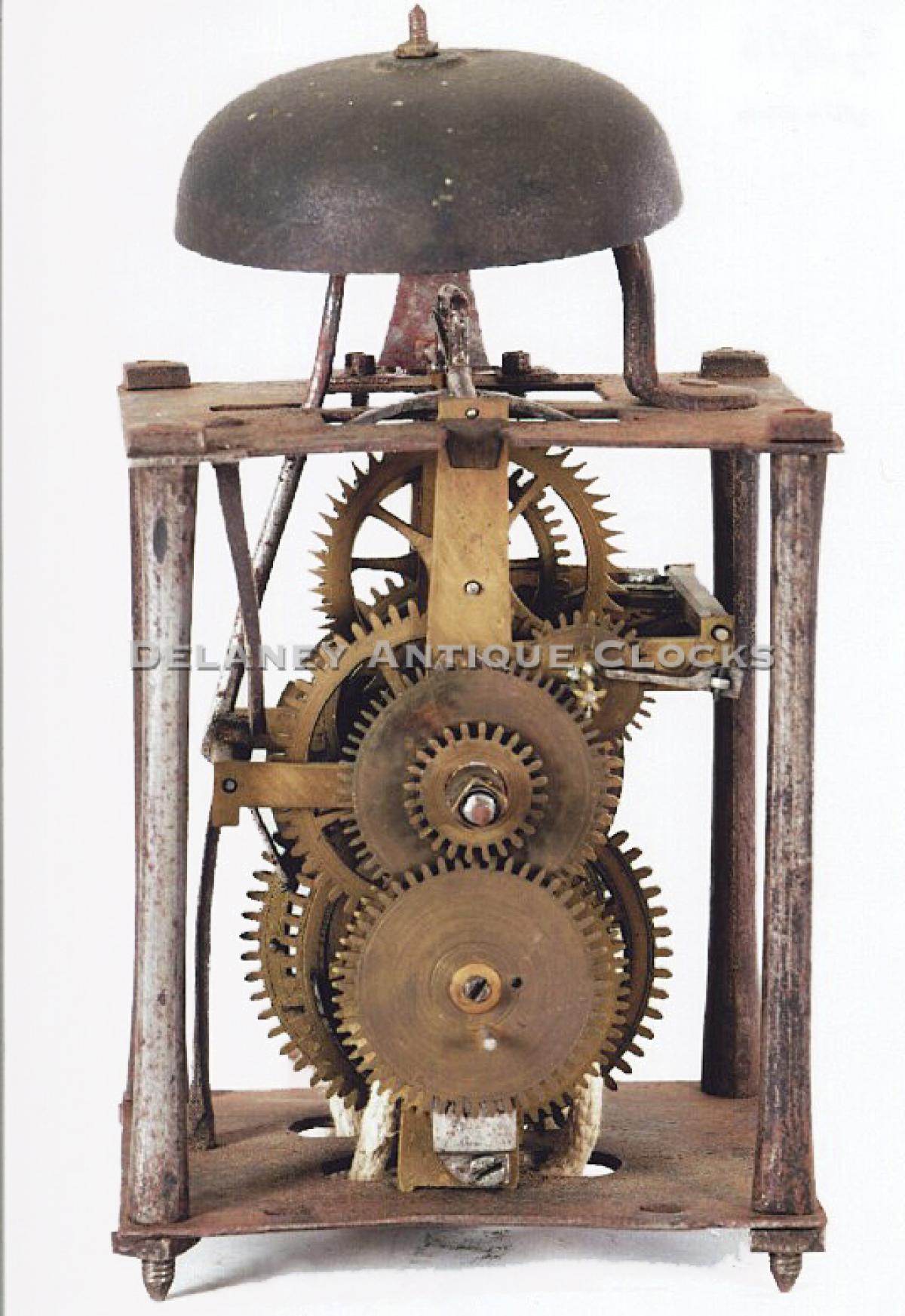David Blasdel of Amesbury, Massachusetts. The patriarch of three generations of clockmakers. This is a pre-revolutionary tall clock made in 1755. VV-100.
This Queen Anne form is constructed in pine, and the surface features a period mahogany-stained finish. The case is very well preserved. The cabinet rests on a sizeable double-stepped base. The moldings are substantially formed, and they transition this lower section to a long narrow waist. Please note the use of dentil molding at both ends of the waist. This center section is fitted with a tombstone shape waist door that opens from the right. This door is trimmed with a simple molded edge. The edges of the waist section are fitted with a quarter-round molding. These are small and transition at each end in a simple lamb's-tongue design. The hood is a flat-top form. The upper molding is substantial and features a dentil detail that ties in nicely with the other two moldings. Quarter-round moldings frame the bonnet. The dial door is rectangular and features an arched opening that is fitted with glass and frames the shape of the dial.
The dial is constructed from a thin brass sheet that is arched in form and undersized, measuring approximately 10 inches across and 13.5 inches tall. The time ring is about 9 inches in diameter. It is engraved with large Roman-style hour numerals, Arabic-style five-minute markers, and a closed-minute track. Inside this ring is a small window that displays the calendar day. The cast spandrels are pewter and lack detail. The Maker's name is crudely engraved in the boss located in the arch. It reads, "DAVID / BLASDEL / 1755."
The clockworks are weight powered. It is designed to be wound daily and to strike each hour on a cast iron bell mounted above it. The works are constructed with an iron frame. Four "dog-bone" shaped posts support cast iron plates that are fitted above and below the brass gearing. This setup format has the look of a cage. The trains are positioned in tandem. The strike train is positioned behind the time train. This makes it possible to use the endless rope arrangement that will power both trains. The count wheel is located on the outside of the rear plate.
The mahogany-stained pine case is 7 feet, 7.25 inches tall, and 20.75 inches wide. The clock appears to be well preserved, having few changes since it was made in 1755.
Inventory number VV-100.
The Blasdel name is spelled in many ways. We have seen it spelled "Blaisdell" and "Blaisdel" in the past. A descendant of David recently informed me that it was originally spelled "Bleasedell" in the early half of the 1600s. The first member of the family to immigrate to the New World was Ralph, who was from Lincolnshire, UK. On his way here, his ship went down off the coast of Kennebunk, Maine, in 1638, and he had to swim to shore. This example is signed with the spelling "Blasdel."
David Blasdel was born in 1712 and worked in Amesbury until he died in 1756. He was killed near Lake George at Fort William Henry while serving as a blacksmith in the last French and Indian War. He was responsible for keeping the troops' arms and armor in good repair. He had an older brother Jonathan (1709-1802), who worked in East Kingston, New Hampshire. Both boys were clockmakers and metalworkers. David was perhaps the more successful clockmaker in that more examples of his tall clocks have been recorded to date.
David had sons who also worked in the trade. David Jr was born in 1736 and died in 1794. Isaac was born in 1738 and died in 1791. Nicholas was born in 1743 and was at work in 1800. David was a Captain in the Revolutionary War with the First Co. out of Maine. In 1770, he settled in Portland, Maine. David Senior also had a grandson named Richard, who made clocks. Richard was Isaac's son. Richard made clocks in Amesbury, MA, Chester, Newmarket, NH, and finally in Falmouth, Maine.
The Blasdels may have been the earliest blacksmiths, silversmiths, woodworkers & clockmakers working north of Boston. The vast majority of the tall clocks made by this pioneering family are easily identifiable. The tall clocks feature one-day iron framed and brass geared movements. These works are constructed with posted frames. The posts are often tapered in the middle and, as a result, are referred to as "dog-bone" posts. The top and bottom were fitted with cast iron plates. This setup format has the look of a cage. The trains are positioned in tandem, i.e., the strike train is located behind the time train. This makes it possible to use the endless rope arrangement to power both trains. The count wheel, usually as much as 3 1/2 inches in diameter, is located outside the rear plate.
Many of the Blasdel dials follow the same form and are somewhat distinctive. They are generally composed of tin or thin brass sheet that is arched in form and undersized, measuring approximately 10 inches across and 13.5 inches tall. The time rings are about 9 inches in diameter. They are engraved with Roman-style hour numerals, Arabic-style five-minute markers, and a closed-minute track. Inside this ring is a small window that displays the calendar day. The cast spandrels are usually pewter and lack fine detail. The Maker's name is engraved in the boss located in the arch. This is usually crudely done.












